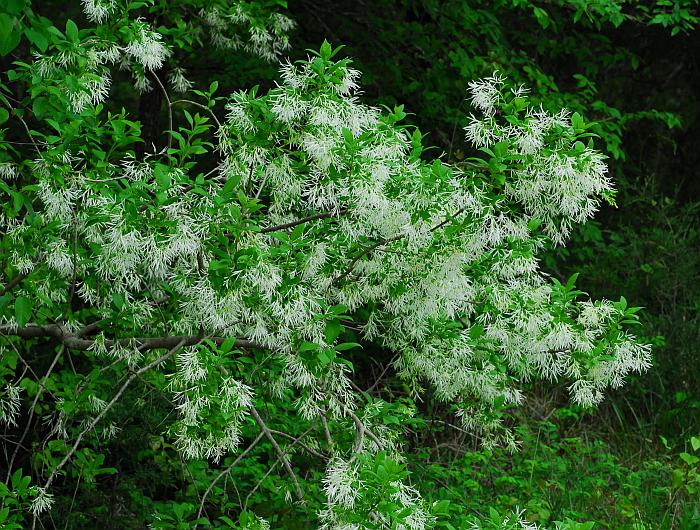Chionanthus virginicus L.
Fringe Tree

Native
CC = 10
CW = 3
MOC = 8
© SRTurner
Chionanthus virginicus L.Fringe Tree | |
 |
Native CC = 10 CW = 3 MOC = 8 |
© SRTurner |
|
Family - Oleaceae Habit - Shrubs or small trees, usually less than 5 m tall, dioecious, sometimes incompletely so. Stems - Spreading to strongly ascending, usually multiple from base, branching. Bark light brown to gray, thin and breaking into small plates, becoming thinly ridged or furrowed with age. Twigs stout, gray or tan, glabrous or short-hairy, circular in cross-section, with raised leaf scars and raised, oval, darker brown lenticels. Terminal buds sometimes closely flanked by the uppermost, shorter pair of axillary buds, ovoid to ellipsoid, with several, overlapping, sharply pointed scales that are spreading at the tips, the axillary buds ovoid, with scales that are broadly to bluntly pointed at the tips. Leaves - Opposite or occasionally subopposite, sometimes appearing clustered toward the branch tips, simple, entire, short-petiolate. Leaf blades 8-20 cm long, 2.5-12.0 cm wide, lanceolate-elliptic to ovate, elliptic, or somewhat obovate, broadly angled to short-tapered to the bluntly to sharply pointed tip, angled or tapered at the base (the upper portion of the petiole often winged), the upper surface dark green and essentially glabrous, the undersurface lighter green or pale and sparsely to densely short-hairy, sometimes mainly along the veins. Petiole pubescent, to 2 cm long.
Inflorescence - Axillary, many-flowered, usually drooping panicles 10-15 cm long, produced from 1-year-old branches, developing with or before the leaves, the lower branch points with small, leaflike bracts, the flowers with slender stalks 5-7 mm long, slightly fragrant. Panicle branches opposite, decussate.
Flowers - Calyces 4-lobed, 1-2 mm long, the lobes triangular. Corollas 4-lobed nearly to the base, 15-30 mm long, the lobes linear to narrowly strap-shaped, at first greenish white, turning white at maturity, glabrous. Corolla tube to 3 mm long, with purple internally. Stamens 2, included, fused to corolla tube. Filaments short. Anthers 1.2 mm long, purplish. Ovary superior, 2-locular. Placentation axile. Style 1-2 mm long, with a pair of ascending branches at the tip.
Fruits - Drupes, 10-15 mm long, ellipsoid to ovoid, olive green, turning bluish black or dark purple, usually somewhat glaucous at maturity Flowering - April - May. Habitat - Glades, bluff tops, ledges, streambanks, bottomland forests. Origin - Native to the U.S. Lookalikes - None. Other info. - There is probably no other native shrub in Missouri which is showier, or easier to identify, when flowering. It is found growing wild in only a few counties, mostly toward the southern end of the state. Its U.S. distribution is southeastern, with Missouri at the northwestern edge of its natural range. It is also a popular cultivated species, deservedly so. It tolerates urban conditions well. Staminate individuals are considered showier. The autumn foliage is typically deep yellow with greenish blotches. Typically the plant is shrubby but it can be grown as a small tree. The plant was used medicinally by Indians, and today as an herbal tonic, although clinical evidence for its efficaciousness is lacking. Photographs taken in Brown Summit, NC., 4-29-03, and in Auburn, AL., 4-17-05 (DETenaglia); also at Drury-Mincy Conservation Area, Taney County, MO, 4-14-2012, and Millstream Gardens Conservation Area, Madison County, MO, 5-21-2020 (SRTurner). |